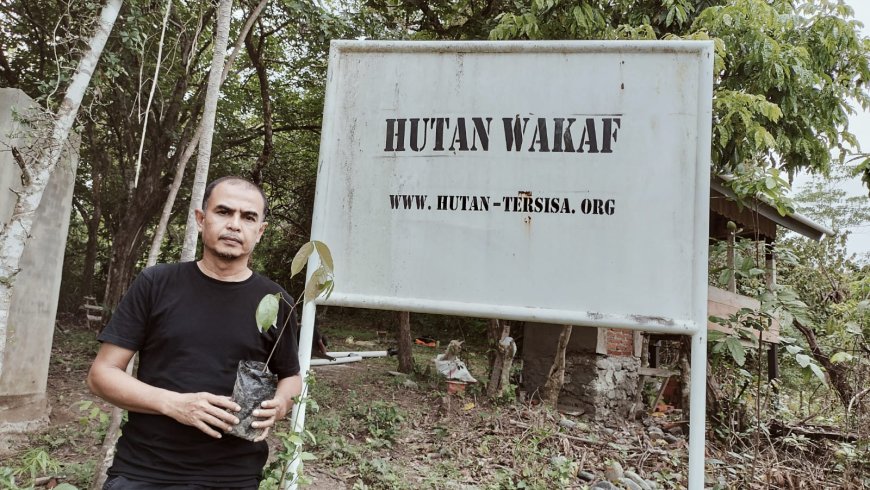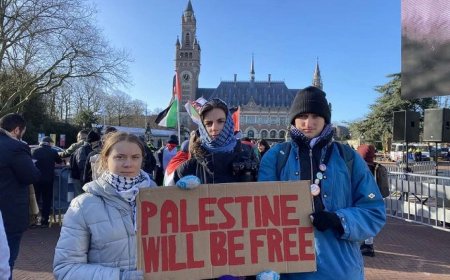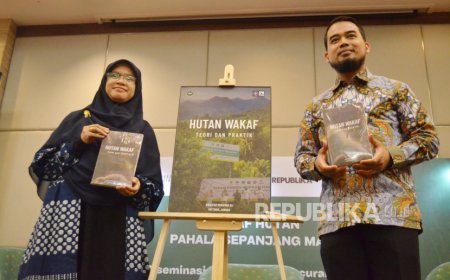Building Waqf Forest in Jantho
Aceh Waqf Forest is located in the palm grove.

MOSAIC-INDONESIA.COM, JAKARTA -- Breathing deeply in the forest. You will fill oxygen amid dozens of trees refreshes bodies that are already contaminated with urban carbon in the daily life. I felt this valuable experience when visited the waqf forest area in Jantho, Aceh Besar, Aceh, on Sunday (4/12) which is 56 kilometers from Banda Aceh. With Afrizal Akmal, one of the founders of the Waqf forest association, i walk around this area that was previously just grassland.
We relax while getting to know the various forest vegetation. The birds and insects are singing as if they accompanied us. The swood and foliage smell makes up humus refreshes the atmosphere. There are a variety of large trees such as banana and teak, as well as fruit trees such as jengkol and jackfruit. There is also a variety of effective trees to treat various diseases such as laban, klayu to benalu. Only about 50 meters had walked, Akmal, greeting his relatives, paused for a moment. “This is the hiding path the little guy took his son,” the 48-year-old explained.
Akmal also showed the tiger claw marks on a tree we crossed. It still appears to be one scratch left. The other two, Akmal said, have been lost as the tree's bark regenerates. Akmal revealed that there is a mother tiger that often hides in the waqaf forest after giving birth. While carrying the cub, she sought a safe place from the male. She didn't want her partner to eat her cub who was still in corn.
Akmal claimed he had never met the tiger. He didn't want to disturb the nearly extinct beast. Akmal believes the tiger will not attack so far as it is not disturbed. The marten will return to its natural habitat in the protected forest once the cub can walk. “I just smell it. Then I turn right,” he said.
Not wanting to linger on the path of the little guy, I asked Akmal to continue the journey. Downhill and uphill dirt tracks drain power. What's more, there were two deep gaps that we had to jump through. Although it was wet, we were lucky that the rain in Jantho was just a splash. We went on our way too.
In the area referred to as the summit, we saw dozens of rocks forming a set. Although no one has yet examined it, Akmal suspects the rocks are a sign of dead people. “It is possible that there is a former battle here. His troops were immediately buried here,” he said. Akmal also points out a natural pond that never dries out despite the arrival of drought. The pool, which is said to have suction mud, became an oasis for animals eager to quench their thirst. The existence of the oasis, Akmal said, is worth investigating given that the area of the waqaf forest is quite high, namely 1,872 square meters.
Akmal watched the land he cared for begin to turn into a forest. If in the past there were only grasslands as a place for cattle and buffalo to eat, the nearly five hectares of land is already overgrown with towering trees. They form a system that absorbs carbon and produces oxygen. No wonder the air in the forest is so cool. According to Akmal, most vetations in the waqf forest fall into the category of pioneer trees. The first plant capable of surviving on critical land.
They grow from roots and seeds in the remaining soil. In the waqf forest, their seeds are carried by the wind or visiting animals from neighboring communities. Akmal explained that many of these animals are already inhabitants of the waqaf forest such as insects, carrion, ferrets and bats. Indirectly, they help the process of seeding plants in the forest either through pollination or seeding through manure. “It can be said that the plants of that animal are 80 percent able to survive and grow as pioneer trees,” explains Akmal.
It was this plant that pioneered the restoration of the forest so that it became the place where other organisms came. Therefore, Akmal was reluctant to remove the shrubs that often grow among the trees except for the purpose of paving the way. For Akmal, forests are not just rows of neatly arranged trees. The litter and grasses that make up the forest floor play an important role because they are sources of humus, the top layer of fertile soil. It is there that insects and various other organisms live while foraging in them.
While listening to the story of the succession of trees in the waqf forest, we took a break after more than half an hour of walking. On the horizon, stretches of forest and river incarnate tubs of paintings that delight the eye. There are also palm plantations lined between the rivers.
Choosing a waqf
Palm oil plantations in Aceh are extensive. Walhi Aceh records show that there are about 540,000 hectares of palm plantations spread across several districts. Walhi Aceh Director Ahmad Shalihin explained that 52 percent are people's estates while 48 percent are owned by corporations.
Shalihin said that the size of the palm oil industry indirectly invited disastrous floods and landslides. Areas such as Aceh Tamiang, North Aceh and West Aceh that have the largest palm oil fields in Aceh are often subject to flooding. “Palm trees in Aceh Besar are not as extensive as in other districts,” he said.
Not only that, palm areas also degrade water quality. Moreover, at the time of land clearing and fertilization. According to Shalihin, the river also experienced sedimentation due to many palm trees falling into the river area. In addition to palm trees, Shalihin revealed, the opening of Jantho-Lamno road access made forest encroachment in the Jantho area continue to occur. This, he said, would also disrupt the flow of rivers upstream. “It's been a month running,” he explained.
Acehnese people refer to the river as Krueng. In Jantho, the Watershed (Watershed) became one of the mainstay water sources of residents even as far as Banda Aceh. Only, many indigenous lands were later purchased to be used as palm plantations, including in Aceh Besar. Although still inferior in size to other districts, palm groves in the district have an area of up to 1,667 hectares including for Jantho region and surrounding areas, based on the 2019-2021 Plantation Statistics Book published by the Ministry of Agriculture.
The expansion of palm plantations has also been assessed by Akmal as harmful to the water quality of rivers and soils. “It's dangerous not to have a campaign for preservation upstream,” he explained. Together with his three friends, Akmal gradually freed up the land around the palm plantation. They chose a waqf scheme so that freed land would not easily switch status. If it is established, the land will remain a forest at any time. “In this area, it may be just this waqf forest that has its status clear,” he explained.
The four friends opened a joint account as savings to free up land. In 2017, their savings reached Rp 15 million. They also freed the first hectare which is now the entrance to the Waqf 1 forest area. Stories of the forest waqf movement were relayed in coffee shops and social media. They also invited local students for rafting on the river “That's where people started asking accounts. We open the donation and then we release it again,” Akmal explained.
Until now, the Waqf forest area already has two locations. First, the place where the Waqf 1 forest stands, covers an area of 3.8 hectares while the next area has an area of 9000 m2 located around the river. Akmal also noted that there were about 400 wakifs -- people who give waqf -- from 2014 to the present. They donated from IDR 50,000 to millions of rupiahs for the acquisition of critical land around Jantho. Akmal carved their names on inscriptions installed at the entrance of Waqf 1 Forest. “Hopefully this waqaf forest can be duplicated anywhere according to the conditions of the society,” Akmal said







